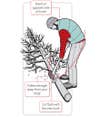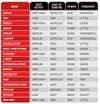Five Timbercraft Skills Every Outdoorsman Should Master
Be a D.I.Y. logger by picking up these basic skills

We may earn revenue from the products available on this page and participate in affiliate programs. Learn more ›

The ability to fell and limb trees, block logs into sections, and split those blocks into firewood is a basic necessity for sportsmen. Know how to correctly wield an ax, chain saw, or bucksaw and you can build a shelter in the wilderness, start a fire, and spit a grouse over the coals. The skills you need to master start with tilting your head and looking up.

1. Felling
Pick Your Tree
Trees fall in the direction of lean or, if straight, to the side with the heaviest branches. Straight or slightly leaning trees are the safest to cut. Determine the direction and degree of lean by using your ax as a plumb line. Hold it loosely by the handle, let the head dangle free, then compare the straight line of the ax with the tilt of the tree trunk.
Be Smart. Never attempt to fell a tree against the lean unless you’re experienced. Reject rotten snags that are likely to break at any point along the trunk, or trees with large dead limbs that can snap off when the trunk sways; they are called widow makers for a reason.
Determine Your Safety Zones
Make sure the tree has a clear path to fall and that you have an unimpeded path for escape. Mentally divide the perimeter around the tree into zones of relative safety before putting saw teeth or ax bit to wood. As the tree begins to topple, place your ax or chain saw (turn it off) on the ground and back away through your predetermined safety zone until you are beyond the reach of the fall. Be Smart. Never turn your back on a falling tree.

(1) Chop (or saw) the facing cut one-third to one-half of the way through the trunk on the side facing the direction of fall. Make the initial cut downward approximately at a 45-degree angle. Then make a second horizontal cut to remove the wedge or notch. Never chop at an up angle, as the ax head could glance off the tree and hit you. (2) Start the back cut in the same manner 2 inches above the facing cut, opposite the direction of fall. Stop when 1 to 2 inches of wood remains intact between the back cut and the facing-cut notch. This is called the hinge. As the tree starts to fall, move to safety.
Note: When making a back cut with a chain saw, you usually do not need to remove a notch. Simply cut horizontally into the tree.
Be Smart. If the facing cut is too deep, the tree may fall backward. Don’t make the back cut too deep or at the same level as the horizontal part of the facing cut, as the tree may spin on its trunk or kick back.

2. Limbing
Chop or saw limbs in the direction in which they grow, typically toward the tree’s top. This will give you a wider chopping angle. And as you cut from the base of the tree upward, you won’t be standing in branches (as you would if you chopped in the other direction).
Be Smart. Keep the trunk between your body and the limb you intend to chop.

3. Blocking
Cut blocks in 18- to 24-inch lengths, depending upon the size of your woodstove. To section blocks with an ax, drag a larger safety log alongside to absorb glancing blows. The log also steadies the trunk for cutting. If you’re using a bucksaw, place the hand that is steadying the log through the bow of the saw, to prevent getting cut if the blade jumps out of the cut. When blocking with a chain saw, make a series of cuts to within 3 inches of the other side of the log, never letting the chain touch the ground (which would dull it in a split second). Use a pole or pry bar to roll the log over, then finish the cuts.
Be Smart. Work on the uphill side because if the log were to roll toward you, the chain saw could jump out of the cut.
SAFETY GEAR CHECKLIST
Safety glasses
Face screen, earmuffs
Leather work gloves
Boots with steel toes
Tight-fitting clothes
Ballistic nylon pants

4. Splitting
Firewood blocks can be split with an ax, but a heavy maul takes less effort and is safer to use. Place the block on top of a larger chopping block (some woodsmen set the block to be cut inside a tire to keep the splits from scattering). Stand a handle length away, then step back enough so you have to lean forward as you swing. Hold the maul at the base of the handle with one hand and put the other hand on the neck. Then raise the maul overhead and bring it down, exerting force only at the end of the swing. Let the weight of the head do the work. Aim for the center of the block (the near side if using an ax).
Be Smart. Split knots through the center, or, better yet, avoid them altogether.

5. Stacking
Before stacking split wood, place two or three poles or 2x4s lengthwise on the ground so air can circulate and prevent mold and rotting on the bottom splits. Stack wood in a single row with the exposed ends facing the winter sun. Alternate the layers at each end of the stack; crisscrossing layers increases stability. If you don’t crisscross the end layers, you’ll need to brace the stack between poles driven into the ground. It’s hard to stack wood more than 4 feet high without losing stability. Cover only the top layer with a tarp (this allows more air to circulate through the pile).
Be Smart. Most green wood needs to be seasoned eight months before it is dry enough to burn without smoking.

Bringing the Heat
Hardwoods burn with fewer sparks, less smoke, and a higher BTU output than softwoods. But keep in mind that softwoods are easier to light than hardwoods and that their smoke can be a godsend in mosquito country, more than compensating for poor heat output.


Cut Deep to Prevent Barber Chairs
When you cut a leaning tree, make the facing cut deeper than usual. Then cut notches from each side of the trunk before making the back cut. If the facing cut is too shallow, the trunk can kick back, leaving a chairlike stump with a splintered back—and taking off your head in the process.
Be Smart. Never attempt to fell a tree that is leaning more than 20 degrees from vertical.

Tool Tips
Ax Fundamentals
When choosing an ax, you can buy a long-handled (36-inch) ax with a 3- to 4-pound head; a small forest ax with a head weighing 11⁄2 to 2 pounds and a handle measuring from 19 to 23 inches; or a hatchet, with a foot-long handle and a much lighter head. A long-handled ax is the safest, as the head will bury in the ground if it glances off a tree. The long handle also lets you apply more power to your swings; the downside is that its size makes it difficult to pack. A forest ax is more portable and is capable of handling most chores, but without as much power. A hatchet, good for cutting small trees or branches, is the most dangerous, as a glancing blow could cut off your foot.
Be Smart. Stay a handle length’s distance from the trunk while felling. Kneel to keep the cuts within 1 foot of the ground; a wild swing will contact the ground first. Use a parallel motion that throws both hands toward the trunk, rather than a circular swing that brings the ax head toward your body.
Bucksaw Basics
A Swede saw with a curved, tubular-steel handle and a 36-inch blade is best for felling large trees, but a lightweight folding bucksaw is more practical for camping trips. A folding pruning saw works great for felling saplings and doubles as a bone saw for butchering game. Use the entire blade for each stroke; the longer the stroke, the shorter the work.
Be Smart. Choose a blade with offset teeth that produce a cut or kerf that is wider than the saw blade. This reduces the likelihood of the saw binding in the cut. If the blade binds, unfasten it and slide it out.
Chain-Saw Facts
A midweight saw with a 16-inch bar is suitable for most chores. Make sure you buy a model with a chain brake, which reduces the risk of kickback if a tooth jams while cutting.
To safely fell a tree, the bar of your chain saw must be longer than the diameter of the trunk. Unless you’re a professional, don’t cut trees with trunks more than a foot thick.
Be Smart. Only cut with the long edge of the bar. Never use the tip to scour out a cut or to contact any other object, as this greatly increases the chance of a tooth jamming and the bar jumping out of the cut.